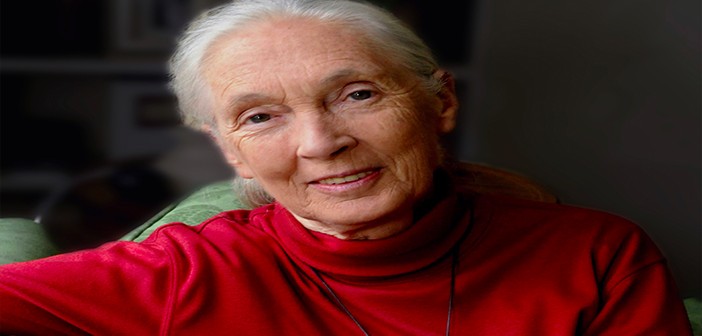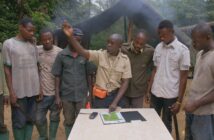In 1960, anthropologist Louis Leakey sent Jane Goodall, a 26 year old native of England with no college degree or scientific experience, to Africa with a mission: learn everything she could about wild chimpanzees. Leakey hoped that information on chimpanzees would shed light on human’s evolutionary past. But for Goodall, studying the chimpanzees just to learn more about them was reward enough. She established the Gombe Stream Research Center to aid her in the task, and 55 years after stepping onto the shore of Lake Tanganyika in modern-day Tanzania, Goodall’s study is still carried out by the Jane Goodall Institute. This Q & A with Dr. Jane Goodall looks back on the last 55 years at Gombe, from the very beginning to her thoughts on the center’s future.
The Q&A is divided into two parts, with this second part focusing on the growth of Dr. Goodall’s work and legacy at Gombe, her decision to pursue consercation work and her thoughts on the future of Gombe. You can read Part 1 here.
How did the research center change as it grew and assistants and associates came to study with you? Did the growth of the camp affect the chimpanzees?
The research centre grew gradually, which became increasingly necessary as more and more chimpanzees were attracted to the banana feeding station. We all worked extraordinarily long hours, observing and writing up our notes. Tanzanian field staff were added to the team to provide continuity and to collect their own valuable long term data. The work of transcribing and analyzing all this information became increasingly onerous.
Initially we lived in tents. Then the National Geographic Society funded the construction of some prefab aluminum buildings – known as uniports. Thus was the research “center” founded. Gradually more students joined us, including those working on Ph.D. research on different aspects of chimpanzee behavior: ranging patterns; feeding preference;, mother infant behavior (my own special interest). In the late 1960s the study of baboon behavior – still ongoing today – was initiated. A few years later a student arrived to study the behavior of the red colobus monkey. There was so much to learn about the chimpanzees relationship with the other animals and plants of their environment.
Did you ever feel that the park was threatened by human development and growth?
In 1960, when I arrived, the forests of Gombe were part of a contiguous belt of forest that stretched along the east shore of Lake Tanganyika, through Burundi, Rwanda and Uganda, and westward to the great forests of the Congo Basin in Central Africa and across to the west coast. When the international logging companies moved into western and central Africa the fragmentation of this forest belt began. Human populations grew. In Tanzania the policy of Ujama – moving scattered farmers into communities – caused major change as large areas of forest were cleared (by the government) for communal agricultural land for each village.
In early 1990 I flew over Gombe and the surrounding area in a small plane. I knew there was deforestation – I was shocked to see that the oasis of forest that was Gombe National Park was surrounded by bare hills. The land over-farmed and infertile. Terrible soil erosion on the steep slopes. Streams clogged up. More people living there than the land could support, and not enough money to buy food from elsewhere.
That is when I realized that unless we helped the villagers we could not even try to save the chimpanzees. So we launched our community conservation program TACARE (TakeCare) to improve the lives of the villagers in environmentally sustainable ways – and in ways that they suggested to our carefully selected team of local Tanzanians. TACARE is a holistic program. Our team worked to enable farmers to grow more food by restoring fertility to the land (without the use of chemicals). We worked with Tanzanian government authorities to improve medical facilities and schools and initiated projects to provide clean eater. We introduced a micro-credit program enabling mostly women to take out small loans to start their own environmentally sustainable development projects, such as a tree nursery. We began to provide scholarships to keep girls in school after puberty along with family planning information. As women’s health improves around the world, family size drops, decreasing population growth.
Each village is required to produce a land use management plan. Under the leadership of Dr. Lilian Pintea, and with the support of Esri, Google Earth, Digital Globe and NASA, high resolution satellite imagery maps have been produced. And the villagers, now our partners, have set land aside for forest regeneration in such a way that these village forest reserves form a buffer between Gombe and the surrounding villages.
Lilian has trained forest monitors – volunteers from all 52 participating villages – in the use of tablets, donated by Google Earth, to record illegal human activities as well as the presence of chimpanzees and various other species. All this information is sent directly to a platform in the clouds, Global Forest Watch, so that it is available to everyone, including village leaders who can take action when necessary.
Corridors of forest planned to link remnant communities of chimps outside Gombe are proving successful: two females, genetically distinct from the Gombe communities, arrived in the park last year.
Choosing to leave Gombe to speak to the world about conservation was a hard choice for you. What finally convinced you that you had to leave?
It happened at a 4 day conference, “Understanding Chimpanzees,” that was organized in Chicago to celebrate the publication of The Chimpanzees of Gombe. For the first time, all those studying chimps in the field, and a few working in zoos, came together to discuss chimp behavior and cultural differences. There was a session on conservation. It was shocking – all field sites reported habitat destruction and many described hunting for the live animal trade or food. There were photos of chimps who had lost a hand or foot in wire snares. And there was a session on conditions in some captive situations, equally shocking – especially secretly filmed footage of chimpanzees in medical research labs and eyewitness accounts of the brutal methods often used in training chimps for entertainment.
I went to the conference as a scientist. I had my Ph.D. I was collecting more data in the field. I had time to analyze and publish my information. Time to write popular books (the reason I originally went to Africa!) and time with students and my son. It was an idyllic life, and one I planned to continue. I left after those 4 days as an activist. I am not conscious of making any decision – I call it my “Damascus moment!”
Who was in charge of Gombe when you left to pursue conservation advocacy, and how did you stay connected to the study you started?
I left Gombe in 1986 and the research was carried on by whichever scientist was heading the Gombe Stream Research Centre. Today the The Jane Goodall Institute continues to run Gombe, with Dr. Deus as director of chimpanzee research, Dr. Anthony Collins as director of baboon research, and Dr. Shadrack Kamenya, director of conservation science. The Tanzanian field staff are highly trained and provide the continuity necessary for long term research on chimpanzees and baboons.
I have always visited Gombe twice a year since 1986, but seldom for more than one week at a time. When I am in Tanzania I spend time with my son and grandchildren in Dar es Salaam, with the chimpanzees and students and staff at Gombe and with the TACARE program in Kigoma.
During gaps in my 300 days a year on the road I go to Bournemouth, to the house where I grew up, with all my books, the trees I climbed as a child. My roots. My sister and her daughter and grandsons lives there and keeps the home fires burning. I am a bird of passage.
I still recognize the chimpanzees I knew so well in the 1980s – such as Gremlin and Gaia, Sparrow and Sandi; but most of my old friends have passed on, and I do not know the younger individuals. However, the forests of Gombe, the sunsets over Lake Tanganyika, provide me with new energy so that I am able to face my grueling travel schedule once more. Gombe is my spiritual home.
Gombe is currently the longest running continuous study of wildlife in the world. What do you see for the future of Gombe? What more can the study tell us about chimpanzees and how does that benefit their conservation?
TACARE is hugely successful and now operates in 52 villages, both around Gombe and in other parts of Tanzania. Around Gombe the forests are regenerating. The hills are no longer bare. Further south we work with villagers to protect still intact forests with chimpanzees.
Gombe has become a model for community centered conservation programs (JGI has initiated similar programs in six other African countries) as a result of our TACARE program, cutting-edge geospatial mapping and ongoing veterinary studies of disease and disease transmission between chimpanzees, other animals and humans.
As well, there is still so much we do not know about the chimpanzees. One of the major scientific contributions of our Gombe research has been to track entire lifespans, as well as family lineages, over time. This provides valuable data on the effects of early experience including different mothering styles, and the effect on subsequent adult behavior. We’ve also been able to perform studies on aging and the spread of new behaviours over time.
And now we shall be able to chart the movement of chimpanzees into and perhaps out of Gombe, thus ensuring the genetic diversity necessary for survival.
Louis Leakey was interested in similarities between chimpanzees and humans – Gombe studies continue to provide fascinating parallels. Leakey’s vision has been justified.





